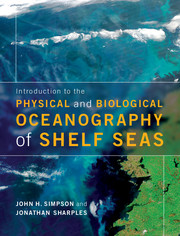Book contents
- Frontmatter
- Contents
- Preface
- Acknowledgements
- Guide to the book and how to make the best use of it
- Symbols
- 1 Introduction to the shelf seas
- 2 Physical forcing of the shelf seas: what drives the motion of ocean?
- 3 Response to forcing: the governing equations and some basic solutions
- 4 Waves, turbulent motions and mixing
- 5 Life in the shelf seas
- 6 Seasonal stratification and the spring bloom
- 7 Interior mixing and phytoplankton survival in stratified environments
- 8 Tidal mixing fronts: their location, dynamics and biological significance
- 9 Regions of freshwater influence (ROFIs)
- 10 The shelf edge system
- 11 Future challenges in shelf seas
- Glossary
- Answers to chapter problems
- References
- Index
- Plate section
9 - Regions of freshwater influence (ROFIs)
Published online by Cambridge University Press: 05 June 2012
- Frontmatter
- Contents
- Preface
- Acknowledgements
- Guide to the book and how to make the best use of it
- Symbols
- 1 Introduction to the shelf seas
- 2 Physical forcing of the shelf seas: what drives the motion of ocean?
- 3 Response to forcing: the governing equations and some basic solutions
- 4 Waves, turbulent motions and mixing
- 5 Life in the shelf seas
- 6 Seasonal stratification and the spring bloom
- 7 Interior mixing and phytoplankton survival in stratified environments
- 8 Tidal mixing fronts: their location, dynamics and biological significance
- 9 Regions of freshwater influence (ROFIs)
- 10 The shelf edge system
- 11 Future challenges in shelf seas
- Glossary
- Answers to chapter problems
- References
- Index
- Plate section
Summary
As we saw in Chapter 2, the input of buoyancy over much of the shelf seas is dominated by heating and cooling through the sea surface. There are additional exchanges of buoyancy at the sea surface through the processes of evaporation and precipitation, both of which modify the salinity of surface layers, but in temperate latitudes their contribution is generally small in comparison with heat exchange. In areas of the shelf adjacent to estuaries, however, freshwater discharge from rivers can make a dominant contribution to buoyancy input (Section 2.3) and maintain strong horizontal gradients of salinity.
In this chapter, we shall consider these Regions Of Freshwater Influence (ROFIs) (Simpson, 1997), the suite of processes which operate within them and the distinctive environment that results. In terms of physical processes, ROFIs have much in common with estuaries, but they differ insofar as estuaries are confined by land barriers and are generally of a smaller horizontal scale than that which is characteristic of ROFIs. In many cases, the circulation in an estuary is predominantly an along-channel flow while transverse motions are relatively small and the effects of the Earth's rotation can be neglected. We shall initially develop the theory of density-driven circulation for such a simplified, non-rotating system before proceeding to consider how rotation modifies the density-driven circulation in ROFIs. We shall next examine the way in which the density-driven circulation is involved in determining the water column structure of ROFIs in competition with stirring and then explore the implications for the biology and environmental health of ROFIs.
- Type
- Chapter
- Information
- Publisher: Cambridge University PressPrint publication year: 2012



